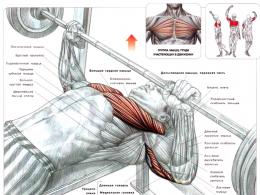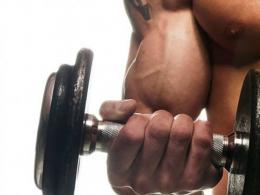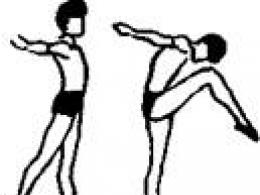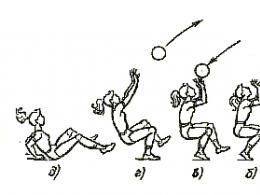Bench press, lying on a horizontal bench. Bench Press: Secrets for Safe and Effective Bench Pressing
The bench press is a very important exercise that allows you to develop the muscles of the chest, as well as the triceps, muscles of the back of the arms and the anterior deltoid muscle of the shoulder and is very useful for both women and men. But all this is possible only if you know how to do the bench press correctly. A and do this exercise. This question includes consideration of grip width, hand placement, back and body, as well as other points. Read on to know all the details.
The bench press can be performed either with dumbbells or a barbell, or in a special machine known as a Smith machine, which limits the movement of the bar in a horizontal plane, so the exercise loses a little in efficiency, although it becomes safer. Other variations include incline bench presses to both sides to emphasize the upper and lower chest respectively.
Technique and body position
- Lie down on a bench under the rack that holds the barbell. Your eyes should be about level with the A-pillar.
- Buttocks, shoulders and head should be tightly pressed and in line with a slight (neutral) curve of the spine. The legs should be flat on the floor with the entire foot, and spaced relatively wide.
- Do a few warm-up presses to get your muscles into action.
- When you're ready, add the main weight to the barbell. Just do it gradually to understand what weight is optimal for you.
- Grasp the barbell with an overhand grip slightly wider than shoulder width, as shown in the photo.

The type of grip depends on which muscle groups will be involved in the first place. With a narrow grip, the load is shifted to the triceps and the middle of the pectoral muscles. With a wide chest. With an average, it is distributed evenly.
- Remove the bar from the rack and lock your elbows before lowering the bar to your chest at nipple level. The bar should descend strictly in a vertical plane, and not in an arc, as most beginners do. This could result in injury!
- Take a deep breath and slowly lower the bar to chest level, but don't lower the bar onto it! Control the movement.
- Squeeze the bar up and exhale at the end. Repeat.
To get used to doing the bench press and for greater safety and correctness, be sure to use a partner for insurance and “guidance” of the exercises.

What are the implementation options?
Arching your back, emphasize the load on the lower sections of the pectoral muscles. This way you can push more weight.
If you lift your legs off the floor and keep them on weight or on a bench, you can completely relieve tension from your lower back and concentrate on working out your chest.
Also, to learn how to properly bench press, be sure to watch the video above. Good luck!
Starting position - lying with your back on a horizontal bench. The buttocks are tightly pressed to the surface of the bench, put the legs on the floor of the entire foot:
Grab the barbell with an overhand grip slightly wider than shoulder width;
Take a breath and slowly lower the barbell to chest level, controlling the movement;
Squeeze the bar and exhale at the end of the movement.

This exercise develops all pectoralis major muscle, pectoralis minor muscle, triceps, anterior deltoid, serratus and coracobrachial muscles.

1 . Grab the barbell with your hands tightly to keep your wrists in a stable position.
2 . Retract your chin and press your head firmly against the bench.
3 . Arch your back to reduce the trajectory of lowering the bar, and give the chest a position in which the lower part of the chest muscles is included in the work as much as possible.
4 . Stick out your chest to reduce the trajectory of lowering the bar.
5 . The buttocks should always be firmly pressed against the bench.
6 . Keep the feet motionless, pressing the heels to the floor, ensuring the stability of the torso during the exercise.

-1 - To ensure maximum safety, it is very important to "lock" the bar with your hands, placing your thumb opposite to all other fingers - "in the lock".
-2 - If the thumb does not "block" the neck, the barbell can slip out of the hands at any time and strike serious injury, falling on the jaw or, even more dangerous, on the neck.
Bench press options while lying on a horizontal bench

01 . classic position.
02 . By arching your back, accentuate the load on the lower sections of the pectoral muscles and you can squeeze out more weight. Perform the exercise carefully to avoid injury to the lower back.
Performing the bench press with an arched back allows you to reduce the trajectory of lowering the barbell and helps to raise heavier weight, since in this case a very powerful lower part of the chest muscles is actively turned on, keep your head and legs motionless. Press your buttocks firmly against the bench.
For lower back pain, this exercise should be excluded!
03 . Raising your legs off the floor and keeping them on weight, you will completely remove problems in the lower back and concentrate on working out the pectoral muscles.
This position of the legs will avoid excessive deflection of the lower back and the appearance of pain in it. This option can be used to reduce the load on the lower group of pectoral muscles, transferring it to the middle and upper bundle of the pectoral muscles.
04 . Pressing your elbows to your sides, you mainly work on the front of the deltoid muscle.
05 . Changing the grip width loads:
- narrow grip: the middle of the pectoral muscles;
- wide grip: the outer part of the pectoral muscles.
06 . Changing the trajectory of the barbell bar loads:
Lowering the bar to the lower edge of the chest, work out the lower part of the pectoral muscles;
Lowering the bar to the middle of the chest, work out the middle section of the pectoral muscles;
Lowering the neck on the clavicular bundles of the pectoral muscle, you work out the upper part of the pectoral muscles.
Application of the exercise - bench press, lying on a horizontal bench
To whom: Everyone from beginner to master.
When: You can turn on chest workouts at any time (beginning, middle, or end).
Large and prominent pectoral muscles have always been held in high esteem. But, in order to make them so, you need to train hard, using effective exercises.
The basic exercise for working out the chest is the well-known bench press. Of course, it is one of the most popular ways to increase the muscle volume of the chest.
Also, this exercise involves the shoulder girdle and arms. In this article, we will take a closer look at the bench press, the correct technique for its implementation and common mistakes, as well as world records of strongmen.
The bench press is a multi-joint basic physical exercise using free weights (free weights include loose equipment such as barbells, kettlebells, dumbbells).
Due to the fact that this exercise involves a significant part of the muscles of the upper body and allows you to achieve a complex increase in their strength and mass, it is an indispensable element of the training process for athletes of various directions.
Also, the bench press exists as an independent sport and one of the three disciplines in powerlifting - powerlifting.
Muscles involved
The main work in the bench press is performed by the large and small pectoral muscles, which are responsible for the movement of the arms in relation to the body and the spread of the shoulder blades.
The assistants are the anterior deltas, serratus anterior, coracobrachialis, and triceps. In different versions of the bench, the load is distributed in a certain way, loading the specific muscle groups listed above with the target impact.
The antagonist muscles in the bench press are the latissimus dorsi and biceps.

Varieties
A complete classification of the whole variety of bench press options is worthy of a separate book, but if we omit purely powerlifting practices and unpopular unusual bench presses (for example, on the floor), then it is worth highlighting the following variations applicable in bodybuilding.
1. Grip width can be classic (medium), wide and narrow. In the classic grip, the palms are slightly wider than the shoulders, which usually corresponds to a distance of 50-60 cm.
It balancedly distributes the load on all the muscles involved in the exercise, without creating its distortion. On the other hand, such versatility does not allow you to fully work out any muscle group.
Therefore, for point loading of a specific muscle group, you need to use more specialized grips: wide and narrow.
A wide grip suggests a greater distance between the palms than a classic grip and significantly engages the pectoral muscles and those areas that are inaccessible to working out with a classic grip.
With a wide grip, many athletes are tempted to use the chest as a shock absorber, “beating off” the barbell from it when lowering. This is a gross violation of the technique of performing the exercise, since the “beating off” knocks down the rhythm of breathing and increases the risk of injury to the chest.
The simple truth is that the bench press on a horizontal bench is considered the optimal choice for pumping the upper body. This detailed guide will show you the correct technique, the list of working muscles and the types of bench presses.
Many pioneers, when they come to the gym, are instantly faced with the wrong technique. Someone needs to point newbies in the right direction. A guide, a photo with instructions or a demo video of this article can serve as an assistant.
The faster we thoroughly study the basics, the better the muscles will begin to grow. It is required to thoroughly study the intricacies of the bench press.
What is bench press
The bench press is the most important basic exercise for gaining significant pectoral muscles and strength. Execution involves the upper body. Breast pumping can increase strength. The table below shows the muscles involved at work.

Muscles involved
You should check out the options.
Classic bench press
Classic style is a popular position. Perform horizontally lying on a bench press. The athlete holds the iron bar under measurements on outstretched arms. Lower, it is necessary to touch the pectoral muscles. Then squeeze to the full amplitude of the arms. The duration of the pause is one second.
Bench press
It is possible to carry out work in the frame, having secured your training. An athlete who has received problems with extensor mechanisms should only practice here. It allows you to limit the amplitude of movement by choosing the right angles for yourself. Pain should disappear. With minimal pain, it is not recommended to press.
Bench press in the Smith machine
The legendary Smith simulator has a multifunctional type of mounts. The athlete lies down on a bench, after fixing the bar horizontally. Plus frames - execution without insurance. A special setting in case of loss of the bar from the hands will save health.
Fast Incline Bench Press
Another kind of bench press. The athlete works at a different angle of inclination. Thanks to the additional trajectory, the upper part of the pectoral muscles is being worked out. The higher you put your head on the bench, the more the load increases.
By changing the grip, you can balance the angular load with different types of grip. Where it is necessary there and the load will go. A wide grip is more aimed at pumping up the middle of the chest, and a narrow grip falls on the triceps and lower chest.
An incline bench will help remove stagnation in the bench press. You need to vibrate the training process, shaking the top, bottom and middle of the chest.
Press one touch or fast
A fast touch press style builds endurance.
Horizontal variation requires the following:
- Grip the bar firmly with both hands.
- Slowly lower the bar with weight.
- You can't push.
- Survive explosive power without exhaling until the elbows are fully extended.
- The feet should be firmly pressed to the floor, the chest should be put forward, bending the lower back forward.
- Slightly flatten your shoulder blades.
Exclusivity from classic squats, the ability to similarly squeeze out large weights. A safe angle prevents the risk of injury. Achieved due to the small angle of the trajectory.

Animated Bench Press Technique
Hand position
Grab the iron bar with both hands. Squeeze the iron firmly with your palms. Distance 60 centimeters from the hands. Use your thumb to cover the top of the round iron part of the fretboard. Five fingers are not advised to be taken together. A little secret - to increase the working weight, you need to strongly squeeze the barbell with your palms.

Correct finger position
Push your chest muscles forward. The position of the gluteal muscles will help to adjust the technique of exposing the chest. Press them tightly to the surface of the bench, arch your back as you stand on the bridge. Twisting the body thus achieves a reduction in amplitude. Increased exercise performance.

For movement, stability is important. Dangling of the body, arms, legs is unacceptable. You can increase the stability due to the shoulder blades on the back. Bring them together and press them against the bench. The barbell can be given to you or removed from the safety holders yourself. The elbows are straight, the legs are pressed to the floor, the chest is exposed and the shell is on the line of the eyes.

The position of the feet on the floor
The position of the feet on the floor is the most problematic place for beginners and experienced athletes. Legs should not run like dancing. Place the soles of your feet under your knees, spreading your legs apart as support pillars. You can't take it off while driving. If the weight is heavy, and the hips of the legs move, then this is normal.

The slope of the projectile must be performed at an angle. The neck at the bottom is forced to lightly touch the chest. Pressing is contraindicated. Violation of the rule is fraught with serious injury. Possible death.

Rotate your elbows 75 degrees. It is impossible to press the elbows to the body due to the lack of full amplitude. The wrists should have one position without hesitation. It is forbidden to spread the elbows to the sides due to the risk of injury. Watch your technique even during small scales.
The upper segment should be held completely on straightened elbows. Heading forward is extremely dangerous. Getting an injury to the elbows, abdomen, head is easy. The tilt back threatens the life of the athlete. Watch your fixation carefully. If you have problems with technique, then ask for help from a specialized trainer. Hone your technique with light weights.

It is unacceptable to press lying down on your own. If you have a bench with safety restraints, then it is allowed. Safety stances will help the athlete protect himself from unforeseen situations.

Proper breathing
Proper breathing is achieved through the starting position. Take the bar in your hands. Lower along the path without exhaling. A good breath provides a more powerful stretching of the chest fibers and fixation of the body.
You can't breathe downstairs. When you have reached half way, you can exhale. You get a powerful reflex push. You can’t empty your lungs so as not to lose control.
Many years of progress and honing of skills in the press contributed to the growth of the overall level. Therefore, it is necessary to highlight the advantageous tips for perfect work:
- The pause at the bottom is no more than one second. Inertia will make it possible to quickly squeeze the weight. After stopping at the bottom, a person at the level of reflexes slows down the movement, and the muscle fibers cease to be fully included in the work. And if there are a lot of repetitions, then it is more difficult to squeeze the weight further. You will have to endure for the scales to move forward.
- Inhalation of air into the lungs is necessary to stabilize the levers of the body. They will be safe thanks to the strongest push. The muscles will start working better, and the joints will not get injured.
- Passing the "dead point" of the most difficult section, you need to exhale strongly.
- Hold your breath for up to 3 seconds.
- The legs serve as supporting shocks for holding and fixing the torso.
Who should do? The exercise is intended for an athlete of any level. The base is best done at the beginning of the workout. Then add, turn on the Svend press, machines and triceps. For strength, do 3-4 sets of 3-6 reps. Endurance 6-12.
There is no more effective simulator than the bench press. Perfectly solves the problem of weight growth and strength indicators. The trajectory falls on the center, but surprisingly, three chest points work. In case of missing sections, turn on additional simulators for refinement.
Basic bench press, strengthens the arms, makes the blow stronger, increases the power of the throw.
Liked? Tell your friends.
Many novice athletes who come to the gym for the first time start with a bench press. This complex multi-joint exercise is on everyone's lips, even for those who are far from sports. Athletes of many disciplines and sports cannot do without it. In weightlifting, in which the snatch and clean and jerk are performed, there are several basic ones, and one of them is the bench press. In bodybuilding and powerlifting, of course, you can’t do without this exercise. Therefore, we will consider its features and technique in more detail, as well as grip options.
Features and Benefits of the Bench Press
The bench press is a basic multi-joint exercise, thanks to which an athlete can work with free weights, and you can load a sports equipment up to extreme weights.
What muscles work with the bench press
This exercise is designed to train most of the muscles in the upper body. The exercise develops as well. If we talk about the technique of performing a bench press with a "bridge", then the work is also included.
- You can start training with this exercise, however, in no case should you perform the exercise without warming up the joints and muscles.
- The first approaches should be performed with small weights. For example, an athlete performs a warm-up approach with an “empty” bar, and the second (it can also be considered a warm-up) with a small weight, which is selected individually.
- Usually the first approach is 12-15 repetitions, during which movements should be performed in a concentrated manner.
- Each approach can be evenly added weight so that the entire range of weights is worked out from the first approach to the last (for example, 4 approaches: the first warm-up - an empty bar; the second - 20 kg; the third - 40 kilograms; the fourth - 50 kilograms). The described kilograms are the total weight of the weight discs, excluding the neck.
Bench Press Technique
The classic version of the exercise is performed in a horizontal position using a bench press.
- In the starting position, the athlete holds the barbell with a wide grip on straight arms. Place your hands on the bar in such a way that in the position when the bar is at the lowest point, the forearms are in a vertical position.
- The movement should be performed without jerking, stopping and “beating” against the chest.
- The movement begins with a slow lowering of the bar to the middle of the chest while inhaling.
- With an exhalation, the bar is squeezed up by the muscles involved in this exercise.
- At the top of the amplitude, do not straighten your elbows. Straightening the elbow joints threatens to cause injury.
- The bench press technique does not imply a pause at the bottom of the amplitude. But in bench press or powerlifting competitions, a pause at the bottom of the movement is required. Return to the starting position is carried out at the command of the judge.
- It takes two seconds to lower the bar in the classic version, after which the sports equipment is quickly squeezed back.

Common mistakes
- By changing the level of movement, for example, moving the bar too high or low from mid-chest, there is a possibility of injury, as well as connecting other muscles to the work, which will reduce the effectiveness of the exercise.
- Another very important point that often ignored - this is a strictly vertical position of the brushes. You can often meet athletes who perform the exercise incorrectly - with the hands bent towards the head.
Bench press variation #2
There is also a second embodiment, when the movement begins with squeezing up. With this method of pressing, the barbell is located on the bench press stops in the chest area. This option is relevant when there is no one to insure when performing an exercise..
Bench press variation #3
The exercise can be performed in a power rack. The bar in the initial position is on the limiters on the sides. The movement starts from the bottom point of the amplitude. such a variant of the barbell press considered the safest of all presented, since when the bar falls, the bar will remain on the limiters and will not crush the athlete. 
This exercise is ancillary and is aimed at overcoming the so-called training "plateau", when progress in weights has stopped. In other cases, it should not be performed. It is best to perform the exercise in a power rack. The exercise gives the maximum load on the pectoral muscles due to the fact that the amplitude during execution is short and does not allow stretching the muscles of the chest and shoulder. 
Bench Press Grip Width
Proper placement of the hands on the bar affects the placement of the forearms, which should be vertical at the bottom of the range. This is what will be the basis of the steam grip. But, despite this, there are other options for the location of the hands on the neck of the bar.
So, bench press can be performed with a narrow and as wide grip as possible.
- Narrow grip switches the load on the triceps and the center of the pectoral muscles,
- and the bench press as wide as possible - contributes to better stretching and filling the chest muscles with blood.
Performing close grip bench press, some athletes complain of pain in the wrist joints, as well as in the shoulders. This is due to an uncomfortable position (non-physiological for some) and curvature of the spinal column. 
Wide grip engages the outer part of the pectoral muscles and the anterior deltoid muscle, and the load on the triceps is reduced. The danger of such a decision- this is an increased load on the elbow joints, ligaments of the anterior deltoid muscle and the shoulder joint. The disadvantage is a decrease in amplitude.

In what position should the bar be lowered
As already mentioned, the bar should be lowered to the middle - the peak of the pectoral muscles. 
However, there are various techniques, for example, barbell guillotine press. It is believed that this technique allows you to greatly stretch the pectoral muscles and increase the effectiveness of the press for those who do not feel the effect of the classical technique. 
There is also a bench press, in which the bar falls below the pectoral muscles(solar plexus area) - recommended in work on the development of strength. But in both the first and second options, there is a chance of getting injured. Both with the barbell press at the level of the clavicles and at the level of the solar plexus, you can feel the fatigue of the anterior deltoid muscle faster than with the press from the pectoral muscles.
How to put your feet
The legs should be set wide, by the way, in the bench press to the maximum, when lifting a large weight with a “bridge”, the legs are not just position fixers. They are in tension when squeezing out a sports equipment along with the muscles of the back, triceps, abdominal muscles and, of course, the chest. In the classical performance of the exercises, the legs serve as a support, with the help of them, the athlete holds the position and does not fall to the side after the swaying barbell.
Features of the bench press with a bridge
The bench press with a bridge is used to train using maximum weights, since almost all the muscles of the body are involved in this technique. The bridge press is a position in which the back is arched. The benches touch only the shoulder blades, which need to be connected as much as possible, and the buttocks. Closed shoulder blades, the widest possible grip and deflection greatly reduce the range of motion. When using a bridge, a large number of muscles are involved, the main of which are the latissimus dorsi. 
Bench press should be performed at the beginning of the workout.
- For mass gain you need to stick to the traditional scheme, namely from 3-5 sets with 8-12 repetitions.
- To work for strength approaches can be done from two to six, and repetitions - no more than five.
This exercise can be performed both solo and included in, performing 15-20 repetitions of 3-4 sets with light weight. For women, the barbell bench press can be substituted in which the barbell is stabilized, as opposed to free weights.
Bench Press Accessory Exercises
- Incline Dumbbell Press- This exercise can be done as an additional load after the bench press for a concentrated study of the pecs, but it can also be done before the bench press as a warm-up exercise and pre-fatigue of the muscles, especially the upper chest.
- Lying dumbbell spread- the exercise should be performed after various presses to stretch and isolate the pectoral muscles.
- Reduction of hands in a crossover- An excellent exercise to refine the muscles of the chest. It can be performed instead of laying dumbbells. And this exercise can also be done using an expander or fitness rubber bands.
Equipment is used only in cases where it is really needed! For example, gloves can be worn if the notches on the neck are not pronounced enough and the hands slip. It is very dangerous! But best of all, for reliable fixation, not gloves, but magnesia or talc will go. Bandages are relevant when performing exercises with a lot of weight, or with a joint injury.
How to replace the bench press
The barbell press can be replaced with a dumbbell bench press or a bench press in the Smith machine. It is found in the gym, which will not be superfluous in working out the muscles of the chest. It is also important to reduce hands in a crossover while standing. Any house is suitable, it is better to perform them, placing your hands narrowly or wide. The best option is push-ups with an expander on the back.
Conclusion
The bench press is a basic high-impact chest exercise that should not be ignored. The bench press should be included in the training process after preliminary preparation of the muscles, or you can work with light weight to hone the technique.
Bench press in video format






